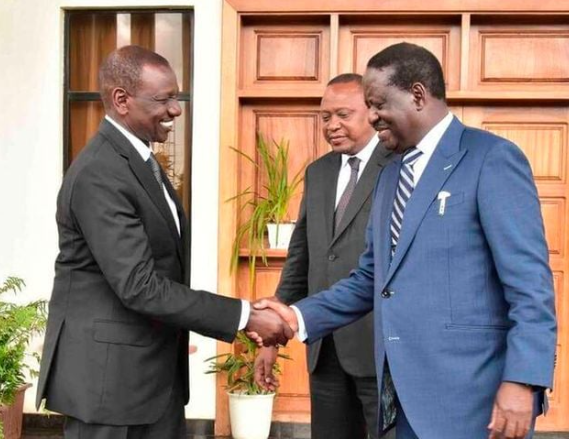Raila Amolo Odinga, Kenya’s long-serving opposition leader, has built his political career on championing democracy, good governance, and the fight against corruption. However, his numerous reconciliations with the country’s past four presidents—Daniel arap Moi, Mwai Kibaki, Uhuru Kenyatta, and William Ruto—have left many questioning whether these moves were for national unity or political self-interest. Critics argue that these high-profile “handshakes” have repeatedly diluted the opposition’s cause and betrayed millions of his supporters.
Handshake with Daniel arap Moi (1997-2002)
In the late 1990s, Raila merged his National Development Party (NDP) with Moi’s Kenya African National Union (KANU), eventually being appointed Minister for Energy. At the time, KANU was widely seen as a symbol of authoritarian rule, and Raila’s decision to join forces with Moi was met with criticism. Many opposition supporters felt betrayed, arguing that Odinga’s move strengthened a regime that had suppressed political freedoms for decades.
Power-Sharing with Mwai Kibaki (2008-2013)
After the highly disputed 2007 presidential election, which led to widespread violence, Raila entered a power-sharing deal with President Mwai Kibaki under international mediation. The agreement saw him take the role of Prime Minister in a coalition government. While this move was presented as a solution to political instability, some of Odinga’s supporters believed it undermined their demand for electoral justice. Critics argued that instead of pushing for fresh elections, Raila compromised by accepting a deal that left Kibaki in power.
The Uhuru Kenyatta Handshake and BBI (2018-2022)
One of the most controversial political moves in recent history was Raila’s 2018 handshake with then-President Uhuru Kenyatta. The handshake led to the creation of the Building Bridges Initiative (BBI), which sought constitutional changes to expand the executive and address historical injustices. Critics viewed this as Raila abandoning his role as opposition leader, effectively weakening political checks and balances. Many NASA (National Super Alliance) supporters who had strongly opposed Uhuru’s government felt betrayed, arguing that Raila had prioritized personal interests over the democratic will of the people.
The Ruto Pact (2025)
In March 2025, Odinga’s Orange Democratic Movement (ODM) signed a cooperation deal with President William Ruto’s United Democratic Alliance (UDA), further fueling accusations of betrayal. The agreement, meant to foster legislative collaboration, has been met with fierce criticism. Opposition figures like Kalonzo Musyoka have condemned the pact, calling it “the biggest betrayal of Kenyans.” Detractors argue that by aligning with Ruto’s administration, Raila has effectively abandoned his role as the opposition leader, leaving the country without a strong government watchdog.
Political Pragmatism or Betrayal?
Supporters of these handshakes argue that Raila’s actions have always been guided by the need to maintain peace and national unity. They claim that his reconciliatory moves have prevented political instability and fostered economic growth. However, critics believe that each handshake has weakened opposition movements, eroded democratic accountability, and disillusioned supporters who once viewed Odinga as the face of political resistance.
As Kenya navigates its complex political landscape, the question remains: Are Raila Odinga’s handshakes necessary steps towards unity, or do they represent a pattern of betrayal against the aspirations of ordinary Kenyans?

